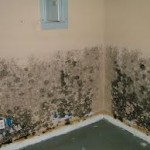Every year our judicial system is filled with million dollar mold liability lawsuits. And there is a good reason why. Mold is what you need to know in a water damage situation, and is sometimes hard to locate due to the nature of which it grows and reproduces. A modern home is a perfect breading ground for mold if the right conditions exist. Due to all the closed wall cavities, organic material, trapped moisture, plumbing and dark areas found in a typical residential dwelling, it should not be a surprise that you need to know mold might be present.
And then, there was the flood of September 2013!
Mold produce tiny spores to reproduce. The spores waft through the indoor and outdoor air continually. When mold spores land on a damp area in side a home, they begin growing and digesting whatever they are growing on in order to survive. Organic material is key for mold to grow. There are molds that grow on wood, paper, carpet and foods.
When excessive moisture or water accumulates indoors, mold will often
occur. The is no practical way to eliminate all mold and its spores in the indoor environment: the key is to control mold is to control moisture. It is important to dry water damaged areas within 24 – 48 hours to prevent mold growth. Mold spores go dormant when the source disappears. If moisture or water is reintroduced, mold will start to grow again. The organic material of the effected area must be replaced i.e. wood framing, drywall, sub flooring, wall paper etc. not just cleaned. If the material is not replaced, mold could start to grow again in the same area.
You may suspect hidden mold if a building smells moldy, but you cannot see the source, or if you know there has been water damage and residents are reporting health problems. Molds may be hidden in places such as the backside of dry wall or wallpaper. Other possible locations of hidden mold include areas inside walls around pipes or inside ductwork.
Investigating hidden mold problems may be difficult and will require caution when the investigation involves disturbing potential sites of mold growth. For example, removal of wallpaper can lead to a massive release of spores if there is mold growing on the underside of the paper. If you believe that you may have hidden mold problems, consider hiring an experienced professional like an Industrial hygienist.
Health effects and symptoms associated with mold exposure should be paid close attention to. When mold problems occur and mold growth results, building occupants may begin to report odors and a variety of health problems. Headaches, breathing difficulties, skin irritation, allergic reactions, and aggravation of asthma. All of these symptoms could potentially be associated with mold exposure. All molds have the potential to cause health effects. Molds produce allergens, irritants and toxins that cause reactions in humans. The types and severity of symptoms depend in part, on four things: types of mold present, the extent of an individual’s exposure, the ages of the individuals and their existing sensitivities or allergies.
Most nationally recognized insurance companies will not cover a mold claim over $5,000. Currently there are no state or federal licensed requirements on how to remove or mitigate the effected areas, so be careful when choosing a contractor to mitigate mold for your client.
Cliff Daniels
Active Properties
720 434 1418
cliff@actprop.com




